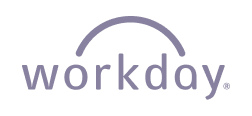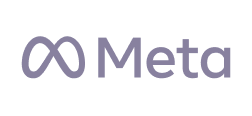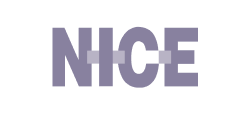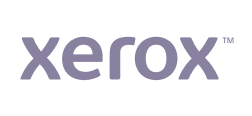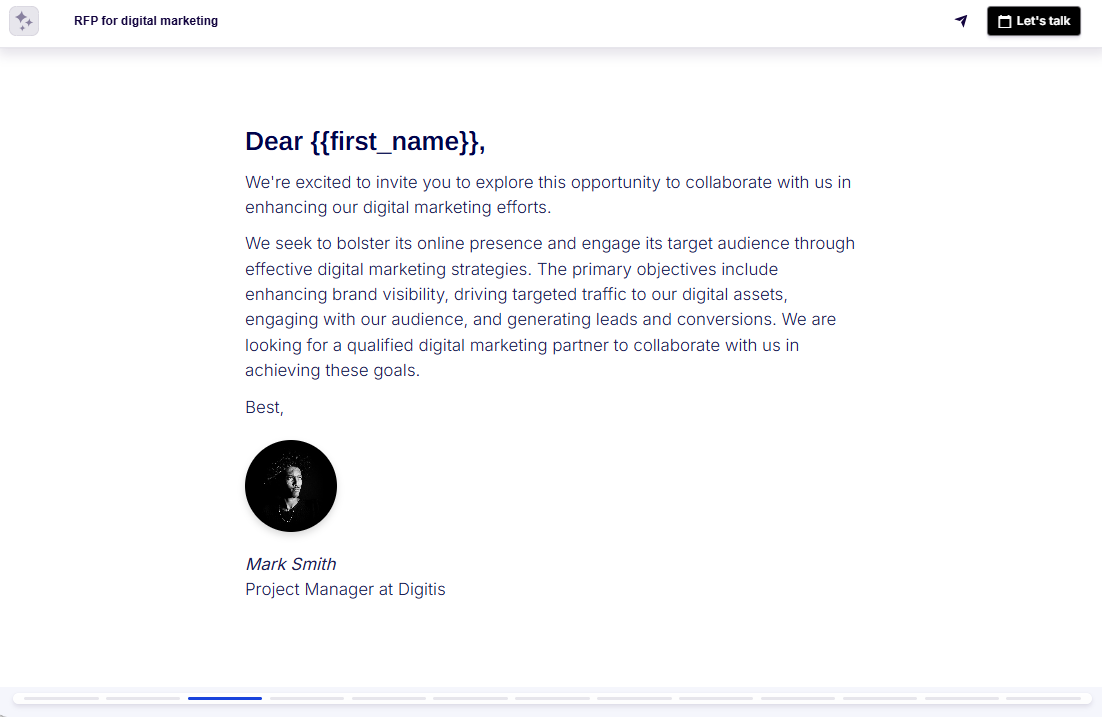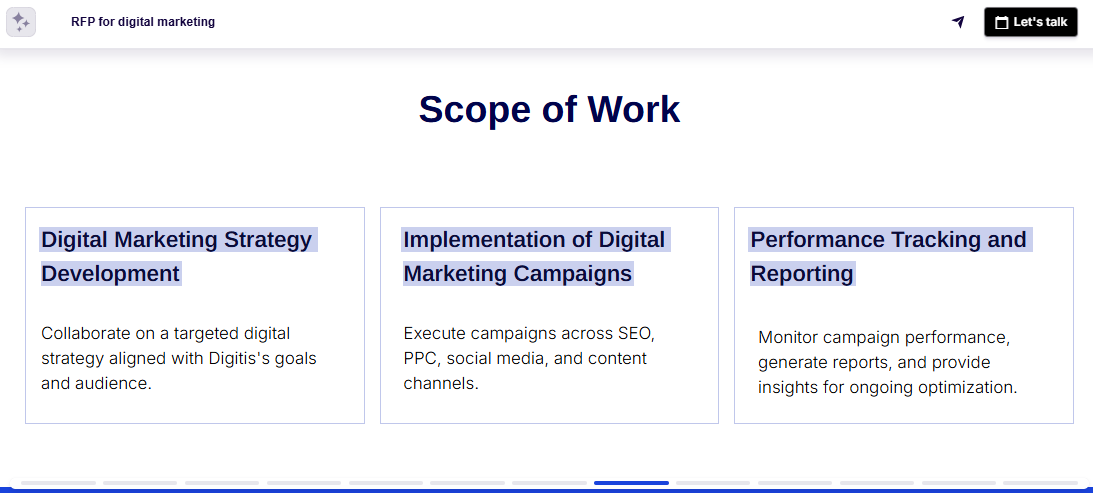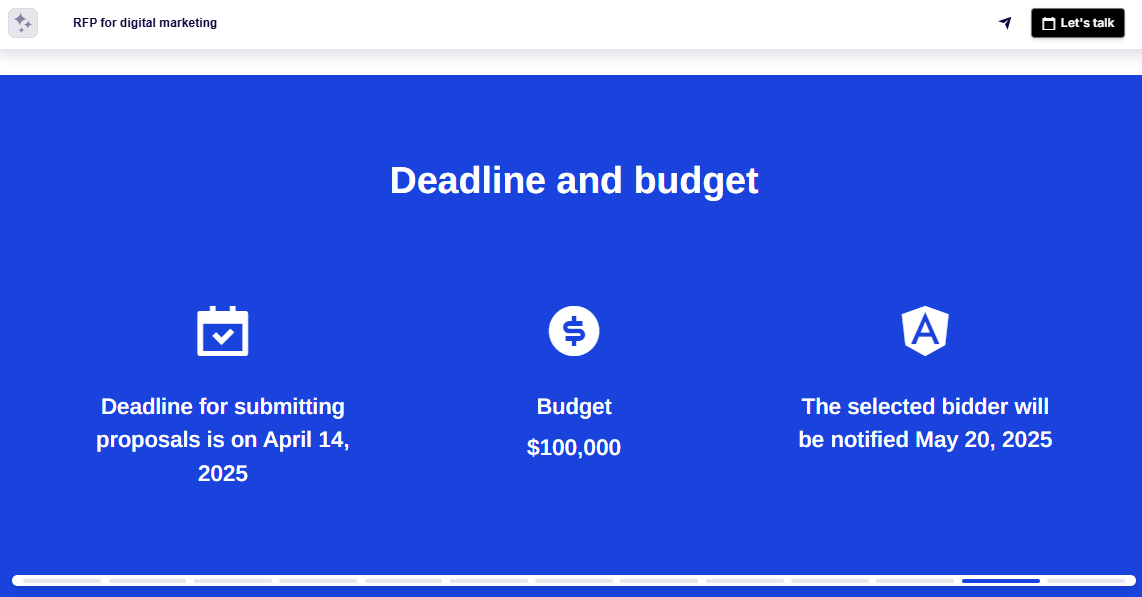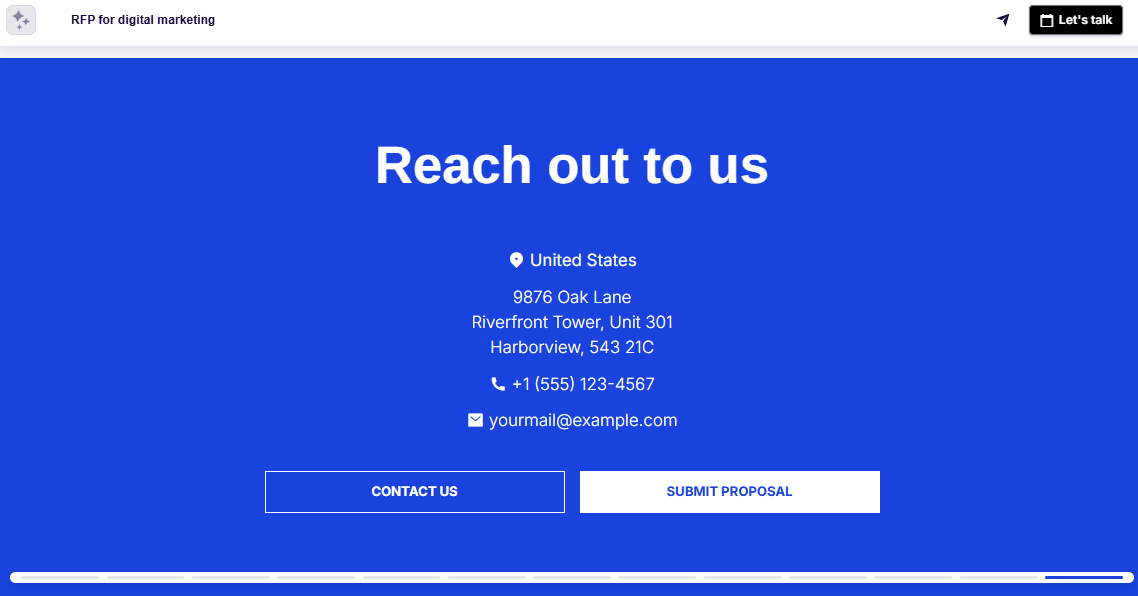How to Write a Winning Marketing RFP (Tips + Template)
Learn how to write an RFP for marketing services to find the right partners for your brand. Get examples and use customizable templates to make your deck.


Learn how to write an RFP for marketing services to find the right partners for your brand. Get examples and use customizable templates to make your deck.
Short answer
A marketing RFP (Request for Proposal) is a document businesses use to find the right agency or vendor for services like branding, SEO, or ad campaigns.
It lays out your project goals, what you need from an agency, and how you’ll evaluate proposals, making it simple to compare options and choose the best fit.
Who is a marketing RFP for?
A marketing RFP is for businesses, nonprofits, or organisations seeking expert help with campaigns, branding, SEO, or digital strategy.
It’s ideal for large projects, like launching a major campaign, rebranding, or managing multiple marketing channels, where tailored solutions and transparency are key.
For simpler needs, like hiring a freelancer or completing a one-off task, a formal RFP may not be necessary.
What are the goals of a marketing RFP?
The goals of a marketing RFP are to define your project’s needs, attract qualified agencies, and evaluate their strategies, costs, and expertise.
It keeps the process clear, inspires well-thought-out proposals, and helps you find the right partner to achieve your marketing goals.
What assets do I need before writing a marketing RFP?
Before writing a marketing RFP, gather key assets like your project goals, budget, and timeline. Take the time to research your target audience, competitors, and industry trends to get a clear idea of what you need and what’s realistic.
Have essential documents ready, like brand guidelines, past campaign results, and technical requirements, to make your RFP clear and simple for agencies to work with.
How to create a strong introduction
Include relevant background information: Give agencies a quick overview of your organisation, including the products or services you offer, the number of employees, or main challenges you’re facing.
Share your mission and values: Explain what your organisation is all about. Highlight your mission, core values, and the big-picture goals that drive your marketing efforts.
Provide an overview of your brand: Describe your brand’s identity, tone, and positioning in the market. For example, are you known for being playful and bold, or is your brand more focused on trust and professionalism?
Explain why this project matters: Share the goal behind your project—are you trying to reach a new audience, launch a product, or rebuild your brand after a big change? Giving agencies this context helps them better understand your priorities.
Highlight your target audience (briefly): Touch on who your audience is and what matters most to them. This can be expanded later in the RFP, but a quick mention here helps set the stage.
How to present your goals and objectives
Be clear about your main goal: Are you looking to boost brand awareness, drive website traffic, increase conversions, or launch a new product? Clearly state your primary goal so agencies know exactly what you’re working towards.
Explain the problem you're solving: If you’re addressing a challenge, such as declining engagement or untapped audience segments, spell it out. This context helps agencies suggest more relevant solutions.
Be honest about your past agency experiences: If you’re switching agencies, explain why. For example, “Our last campaigns didn’t hit engagement goals because they lacked strong audience targeting. This time, we want a partner who can take a more strategic, data-driven approach.”
Tie goals to measurable outcomes: Where possible, connect your goals to specific metrics. For example, “Increase organic traffic by 20% in six months” is much clearer than “Improve SEO.”
Highlight key milestones: Break the project into phases or key steps, especially if it's a long-term initiative. This helps vendors structure their proposals and plan their timelines effectively.
Consider long-term objectives: Share how this project fits into your broader marketing strategy. For instance, if you’re laying the groundwork for a multi-year initiative, let agencies know.
How to create a solid scope of work
List the key tasks: Break down the project into the specific tasks you need done. For example, “Develop a content strategy,” “Run a three-month paid social campaign,” or “Design a new brand logo.”
Set clear deliverables: Specify the results you expect, like 10 blog posts, a complete ad campaign, or a 20% increase in email open rates. Clear deliverables make it easier for agencies to focus on outcomes.
Share target audience insights: Give agencies a clear picture of who they’re targeting by sharing key details about your audience—like their demographics, challenges, and behaviours.
Highlight any special requirements: Let agencies know about any specific tools, platforms, or standards they’ll need to work with. For instance, “Content must be published through our CMS” or “Ads should comply with GDPR regulations for the EU market.”
Flag potential challenges or roadblocks: Be upfront about obstacles that might affect the project. For example, your website might have technical limitations, like slow loading speeds or outdated design, that could impact campaign performance. Or you may face tight deadlines, or require approvals from multiple stakeholders, slowing down decision-making.
Include key questions for agencies to answer: Ask specific questions that help you evaluate their fit for the project. They can be simple yes/no questions, or open-ended ones that showcase their way of thinking, like:, “How would you approach targeting [your audience]?”, or “What metrics do you prioritise to measure success?”.
Set clear reporting expectations: Let agencies know how you want to track progress and results. For example, “We’d like monthly reports that include key metrics, campaign insights, and recommendations for improvement.” Mention any preferred formats or tools, like dashboards in Google Data Studio or detailed PDF reports.
How to present your project timeline
Include key milestones: Highlight important points along the way, like campaign launches, content approvals, or reporting deadlines. For example, “Complete the ad creative by July 15” or “Launch the email campaign on August 1.”
Be realistic about deadlines: Allow enough time for each phase of the project to ensure high-quality work. Unrealistic deadlines can lead to rushed results, so build in a little extra time for complex tasks.
Highlight dependencies: Clearly explain tasks that depend on your team’s input or approvals to keep everything moving smoothly. For example, “SEO optimisation can only begin once website updates are completed and approved by our team.” This helps agencies understand how their work fits into the overall process.
Account for unexpected delays: Allow room for unexpected delays, like website issues, last-minute changes, or feedback delays. A little flexibility can go a long way in keeping the project on track, even when things don’t go as planned.
Communicate decision timelines: Let agencies know when you’ll make your final decision and how they’ll be informed. For example, “We will notify the selected agency via email by April 1, 2025.”
Make the timeline easy to understand: Use a table, chart, or timeline slide to lay out key dates and milestones in an easy-to-read format. Keep it simple and visual so agencies can quickly understand the schedule at a glance, without having to sift through paragraphs of text.
How to present your budget
Do your homework: Look into what agencies typically charge for the type of work you need. Research industry benchmarks or ask for advice from peers to get a realistic picture of what to expect.
Be honest about your range: Share a clear budget or range, even if it’s broad. For example, “We’re budgeting $50,000 to $70,000 for this campaign.” This lets agencies know if they’re a good match and avoids any unnecessary guessing or overestimating.
Explain any constraints or flexibility: If your budget is fixed, say so. If you can stretch it for outstanding work, let them know. For instance, “We’re open to higher costs if they come with proven ROI or premium services.”
Highlight priorities: Show where you’d prefer the money to go. For example, “We want most of the budget focused on paid ads, with a smaller portion allocated for content creation.” This ensures agencies know what’s most important to you.
Think beyond this project: If this is part of a bigger marketing plan or you’re open to a long-term relationship, let agencies know. They may offer pricing that reflects the value of an ongoing partnership.
How to define your evaluation criteria
Focus on what's most important: Identify the key things you’re looking for, like creativity, industry knowledge, measurable results, or budget. Be specific about what will make a proposal stand out to you.
Assign priorities or weights: Not all criteria carry the same importance. For example, creativity might account for 40% of the decision, while cost is 25%. Sharing these priorities helps agencies focus on what matters most.
Be clear about must-haves vs. preferences: Let agencies know what’s absolutely essential and what’s just a bonus. For example, you might require an agency with experience in paid social campaigns but would love one that’s also skilled in influencer marketing. This helps them focus on meeting your must-haves while highlighting any additional strengths they offer.
Consider the intangibles: Don’t ignore softer factors, like how well an agency aligns with your brand values or how easy they are to communicate with. These can make or break a partnership.
Publish your criteria in the RFP: Share your evaluation process in the document itself. It shows transparency and ensures agencies know how their work will be assessed.
How to write submission guidelines
Be clear about deadlines: Specify the exact date, time, and time zone for submission. For example, “Proposals are due by 5:00 PM EST on March 15, 2025.”
Explain how to submit: Let agencies know how to submit, such as via email or a submission portal, and specify the preferred format (e.g., PDF). Include basic naming conventions if needed, like “[AgencyName]_MarketingProposal.pdf.”
Tell them what to include: Give a simple list of what you need in the proposal, like their approach, timeline, and budget. A clear structure helps agencies stay on track and makes your job easier when reviewing.
Keep it manageable: Set a clear page or word limit, like “Proposals should be no longer than 10 pages,” to avoid lengthy, hard-to-review submissions.
Handle questions early: Let agencies know how and when they can reach out with questions, and set a cut-off date for inquiries. For example, “All questions must be submitted by March 1, 2025.” This keeps the process on schedule and avoids last-minute confusion.
What to include in your contact section
Name a primary contact: Assign one person or team to handle all communication. Include their name, email address, and phone number to ensure agencies know exactly who to reach out to.
Set communication boundaries: Let agencies know when they can expect responses, like, “We’ll reply to all questions within 48 hours during business hours, Monday–Friday.” This keeps expectations clear and manageable.
Embed a calendar for meetings: If you’re using an interactive RFP format, consider embedding a scheduling tool. This allows agencies to easily book time for more in-depth discussions or clarifications.
Documents to include in your RFP for marketing services
Brand guidelines: Share your brand’s tone, style, colours, and messaging framework. This helps agencies ensure their strategies and ideas align with your identity.
Campaign history: If you’ve run similar campaigns in the past, include performance data or lessons learned. For example, “Our last social media campaign increased engagement by 30%, but we struggled to convert clicks into leads.”
Target audience research: Provide key insights about your audience, like demographics, behaviours, and pain points. The more agencies understand who they're targeting, the better their proposals will be.
Technical specifications: Include any must-know details about platforms, tools, or systems the agency will need to work with, like your CMS, CRM, or analytics setup.
Terms and Conditions: Specify any legal or contractual requirements upfront. For example, outline expectations for contract renewals, payment terms, intellectual property ownership, and confidentiality agreements (NDAs) if applicable.
Stop losing opportunities to ineffective presentations.
Your new amazing deck is one click away!
